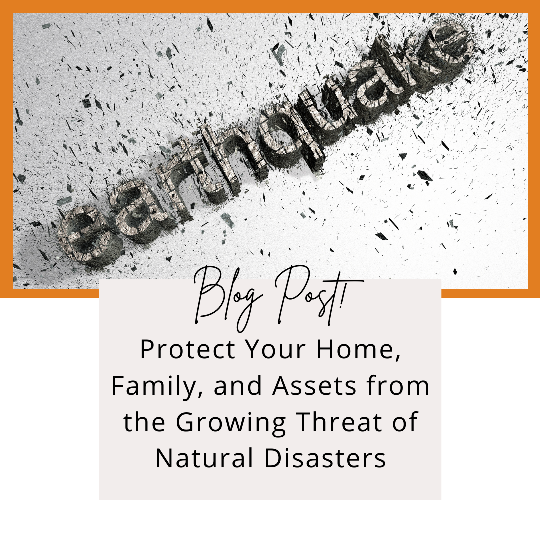In recent years, we’ve seen historic levels of damage caused here in the US, and around the world, by natural disasters. From Texan blizzards to California wildfires Louisianian hurricanes Louisiana and Midwest tornadoes, few areas of the country are immune to such disasters. And based on the latest data from the United Nations World Meteorological Organization (WMO), things are only going to get worse.
According to the WMO, climate change has helped drive a five-fold increase in the number of weather-related catastrophes in the past fifty years, and these disasters are getting more severe each year. Weather records are being broken all the time, turning previously bad scenarios into deadly realities.
Despite this threat, the majority of homeowners lack the right type of insurance coverage needed to protect their property and possessions. According to a 2020 report from CoreLogic, the nation’s largest source of property and housing data, roughly 64% of homeowners don’t have enough insurance. One major contributing factor to this lack of proper insurance coverage is the mistaken belief that homeowners insurance, alone, offers adequate protection from natural disasters
In reality, much of the damage caused by natural disasters is not covered by standard homeowners’ insurance policies.
To completely protect your home and your other property, you often need to purchase a separate insurance policy or endorsement that covers specific types of natural disasters.
To help you get the proper coverage, I’ve highlighted below the various types of insurance available and explained what these policies typically will—and won’t—cover.
Wildfires
Although homeowners’ insurance typically does not pay for damage caused by natural disasters, most policies do cover fire damage, including wildfires. Usually, the only instances of fire damage that a homeowners’ policy won’t cover are (1) fires caused by arson or (2) when fire destroys a home that has been vacant for at least 30 days before the fire occurred.
That said, not all homeowners’ policies are created equal, so you should review your policy to make certain that it includes enough coverage to do three things: (1) replace your home’s structure, (2) replace your belongings, and (3) cover your living expenses while your home is being repaired (this is usually known as “loss-of-use” coverage).
What’s more, in areas that are extremely high-risk for wildfires, such as our desert community, it can be difficult to find a private company to insure your home. In such cases, you can look into state-sponsored fire insurance, such as California’s FAIR Plan.
Earthquakes
Unlike fires, earthquakes are typically not covered by homeowners’ policies, and they certainly are not covered here in southern California. To protect your home against earthquakes, you will need a freestanding earthquake insurance policy.
While earthquake insurance is available just about everywhere, policies in high-risk areas including ours typically come with high deductibles, ranging from 10% to 15% of a home’s total value. Further, even though earthquake insurance covers damage directly caused by the earthquake, some related damage, such as those caused by flooding, will likely not be covered under the earthquake policy.
Carefully review your policy to see what is and what isn’t included.
Floods
Although homeowners’ insurance generally covers flood damage caused by faulty infrastructure such as leaky or broken pipes, nearly all policies exclude flood damage caused by natural events like heavy rain, overflowing rivers, and hurricanes. To protect your property and possessions from these events, you’ll need stand-alone flood insurance.
While we don’t have to face the possibility of floods that frequently out here in the Coachella Valley, there’s always one or two major flooding episodes each year. If you are in one of those areas, please, please, please talk with your insurance agent about whether or not you need a separate flood insurance policy.
Even if you don’t live in a location where flood insurance is required, you may want to consider buying it anyway because 90% of all natural disasters include some form of flooding, and more than 20% of flood-damage claims come from properties outside of high-risk flood zones.
Document Your Possessions
In the event that you do need to use one of your policies to replace your property, you will be asked for a detailed list of your possession, as well as proof that you actually owned those possessions. That’s why I recommend that you walk around your home and take photos of your possessions at least annually, and keep those photos on a USB or cloud storage so you have it in case you need it. The last thing you’ll want is to be denied a claim because you can’t prove what possessions you owned, or have to go through the hassle of scouring credit card receipts and bank statements to prove to the insurance company you owned what you claim you owned. I’ve been there and done that (and gone to trial with an insurance company on behalf of a client) over this very issue.
Be Ready To Go: Pack A Go-Bag
Beyond having the right insurance, if your family is forced to evacuate your home in an emergency, you’ll need important documents and supplies on-hand to recover in the wake of the catastrophe. I recommend you take a cue from the U.S. military, which requires its members to always have a “go-bag” ready and packed with essential items needed to survive outside of your home for at least three days.
You’ll want to make sure you have clothes, toiletries, medications, and food, in addition to copies of your passport, birth certificate, driver’s license, state ID card, and/or other essential identification. Other documents to pack include a copy of the deed to your home, copies of your insurance policies, the original copy of your will, vehicle titles/registration, and a recent family photo with faces clearly visible for easy identification.
While copies of all your estate planning documents should be included in your go-bag, having your advance healthcare directive and HIPAA authorization readily accessible is especially critical for medical emergencies. Without these documents, doctors and other medical professionals won’t know your wishes for treatment or who should help them make decisions on your behalf in the event of your incapacity from illness or injury, which is all the more likely during a disaster scenario.
To make everything as portable as possible, download your estate plan and other important documents to a flash drive you can carry in your go-bag and upload additional copies to the cloud.
Finally, make sure your family knows about your go-bag and estate planning documents—as well as how to find them. Even if you have all the necessary legal documents in place, they will not do you any good if your loved ones do not know about them or cannot quickly locate them during an emergency. You might even want to keep your go-bag near your home’s primary exit or garage, so you or someone else can grab it on the way out the door.
Preserving Your Family’s Most Precious Mementos
Obviously, not all of your family’s belongings can be replaced, so you should take additional precautions to safeguard your most precious sentimental items: photo albums, home videos, old letters, family histories, and treasured cards from the past. Since you won’t have the time or space to pack these items in your go-bag, I recommend you make digital copies of these keepsakes and store them in the cloud.
As your personal lawyer, I am keenly aware of the priceless value these items represent, and I believe safely storing your sentimental items online is so important we offer this as a service to all of our clients. Be sure to ask us how we can help you preserve your family’s most precious mementos.
Protect Your Home & Family Today
To make certain that you have the proper insurance and other estate planning documents in place to protect your home, family, and belongings from the ever-increasing threat posed by natural disasters, reach out to me to schedule your Family Wealth Planning Session. I will help you evaluate the specific risks for your area, assess the value of your home and other assets, and support you to obtain the proper insurance and estate planning tools to fully safeguard you and your loved ones from every possible emergency. Call us today to get started.





